Overview of the Issue
CHIC--The Canine Health Information Center
The Canine Health Information Center, also known as CHIC, is a centralized canine health database jointly sponsored by the AKC/Canine Health Foundation (AKC/CHF) and the Orthopedic Foundation for Animals (OFA). The program was originally conceptualized by the AKC Delegate Parent Club and Canine Health Committees. The AKC CHF and OFA took on the project, and implemented it in the Fall of 2001 with eight pilot breeds participating. Today, nearly one third of the AKC Parent Clubs have joined CHIC, and nearly 20,000 dogs have met the individual breed health testing requirements and been assigned CHIC numbers.
The CHIC Mission Statement is quite simply "To provide a source of health information for owners, breeders, and scientists, that will assist in breeding healthy dogs." The specific program goals are:
 To work with parent clubs in the identification of health issues for which a central information system should be established.
To work with parent clubs in the identification of health issues for which a central information system should be established.
 To establish and maintain a central health information system in a manner that will support research into canine disease and provide health information to owners and breeders.
To establish and maintain a central health information system in a manner that will support research into canine disease and provide health information to owners and breeders.
 To establish scientifically valid diagnostic criteria for the acceptance of information into the database.
To establish scientifically valid diagnostic criteria for the acceptance of information into the database.
 To base the availability of information on individually identified dogs at the consent of the owner.
To base the availability of information on individually identified dogs at the consent of the owner.
The CHIC database is a tool that collects health information on individual animals from multiple sources. As more phenotypic and genetic screening tests become available and breeders make greater use of these tests, it is important that a database exists to capture this data. CHIC satisfies this need by functioning as a centralized pool of data. CHIC is about encouraging testing and health awareness and recording the results. It is not necessarily about 'normalcy' nor should it be misconstrued as an award program for normal dogs. Dogs with abnormal results are eligible for CHIC numbers as long as their results are in the public domain so that the breeders can benefit from the information in making more informed breeding decisions.
Core to the CHIC philosophy is the realization that each breed has different health concerns. Not all diseases have known modes of inheritance, nor do all diseases have screening tests. Some screening tests are based on phenotypic evaluation, others on genetic testing. With all these variables, a key element of CHIC is to customize or tailor the CHIC requirements to the needs of each breed. These unique requirements are established through input from the parent club prior to the breed's entry into the CHIC program. Breed specific requirements typically consist of the inherited diseases that are of the greatest concern and for which some screening test is available. Each parent club also drives specific screening protocols. As an example, one parent club may allow cardiac exams to be performed by a general practitioner. Another parent club may require the exam to be performed by a board certified cardiologist. A club may also use the CHIC program to maintain information on other health issues for anecdotal purposes. Later, as screening tests become available, the disease may be added to the breed specific requirements.
Regardless of breed, each dog must be permanently identified in order to have test results included in CHIC. permanent identification may be in the form of microchip, or tattoo.
CHIC operates an informed consent database. All information regarding test results remains confidential unless the owner specifically authorizes release of the information into the public domain. Owners are encouraged to release all test results realizing it is in the ultimate health interests of the breed and the information greatly increases the depth and breadth of any resulting pedigree analysis. For those not quite ready to accept open sharing of information, there is still value in submitting their results. All test information entered into the database is available in aggregate for research and statistical reporting purposes, but does not disclose identification of individual dogs. This results in improved information on the prevalence of the disease, as well as information regarding progress in reducing the incidence of the disease.
A CHIC number is issued when test results are entered into the database satisfying each breed specific requirement, and when the owner of the dog has opted to release the results into the public domain. The CHIC number by itself does not imply normal test results, nor should it be interpreted as a 'stamp of approval" for breeding. The CHIC number only indicates that all the required breed specific tests were performed and the results made publicly available.
When a CHIC number is issued, a CHIC report is generated. The CHIC report is a consolidated listing of the tests performed, the age of the dog when the tests were performed, and the corresponding test results. As new results are recorded, updated CHIC reports reflecting the additional information are generated. For example, if a breed requires annual CERF examinations, an updated CHIC report will be generated every time updated CERF results are entered.
| Figure 1. - A sample CHIC report. | 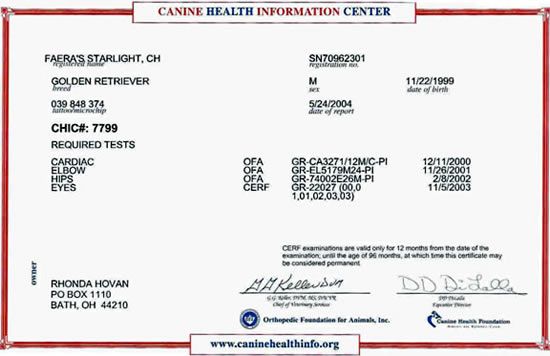
|
|
| |
Once included in the CHIC program, the breed specific requirements are dynamic. As health priorities within a breed change, or as new screening tests become available, the breed specific requirements can be modified to reflect the current environment.
Health testing by itself is only the first step in attempting to reduce the incidence of genetic disease in our companion animals. It is important to take the next step and record the results in genetic health registries so that the data is preserved and others may benefit from it. Finally, the website brings things full circle by making the information easily accessible to the public via the internet. The CHIC website is located at www.caninehealthinfo.org. The website contains basic information on CHIC such as its mission and goals, and maintains a listing of the participating breeds and approved breed specific test protocols. The CHIC website also provides a search engine to locate dogs that have been issued CHIC numbers, their test dates, and the results of their tests. The website has been designed to seamlessly integrate with the existing OFA website.
The OFA and CHIC search engines allow queries to be very broad or very specific. Search criteria include registration numbers, registered names (including full name, first part of name, any part of name), breed, sex, birthdate (or range), specific disease registry, specific diagnostic rating, and report date (or range). Any combination of these search criteria can be specified resulting in a variety of potential matches.
Click on the image to see a larger view.
| Figure 2. | 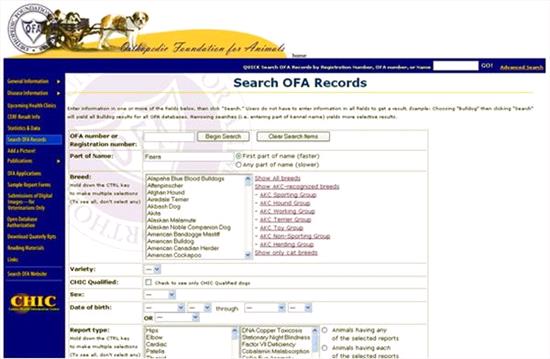
Screen Shot from the OFA website displaying the search criteria screen. In this example, the kennel name "Faera" was entered as the search criteria. |
|
| |
Click on the image to see a larger view.
| Figure 3. | 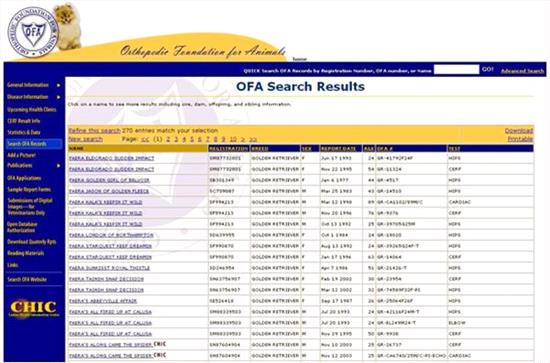
Screen Shot from the OFA website displaying the results using the search criteria of "Faera" in the name field. |
|
| |
| Figure 4. | 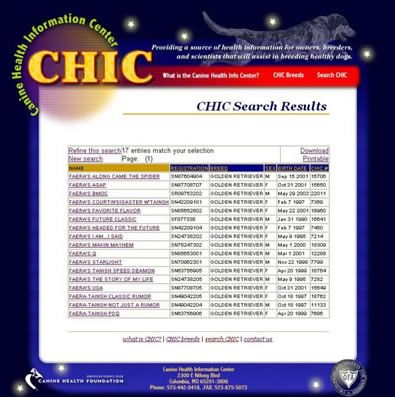
Screen Shot from the CHIC website displaying similar search results using the criteria of "Faera" in the name field. |
|
| |
Once an individual dog is selected through the search options, detailed information is displayed, including health screening done, age at the time of testing, and test results. In addition, wherever possible, the database does a pedigree query, and displays the dog's sire and dam, siblings (both full and half), offspring, as well as any of their recorded health test results. All displayed names are hotlinked, so the user can easily browse from dog to dog.
Click on the image to see a larger view.
| Figure 5. | 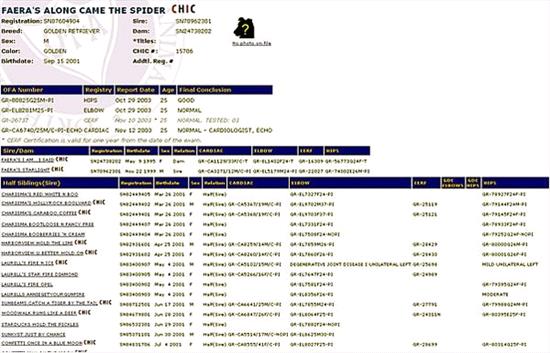
Screen Shot from the OFA website displaying individual dog record. Whether searching from the OFA site or the CHIC site, the individual dog records such as the one above are seamlessly accessed from either. |
|
| |
Another unique feature is the vertical pedigree analysis which encourages breeders to truly analyze the depth and breadth of a pedigree in a vertical fashion rather than the simple more traditional horizontal method.
Click on the image to see a larger view.
| Figure 6. | 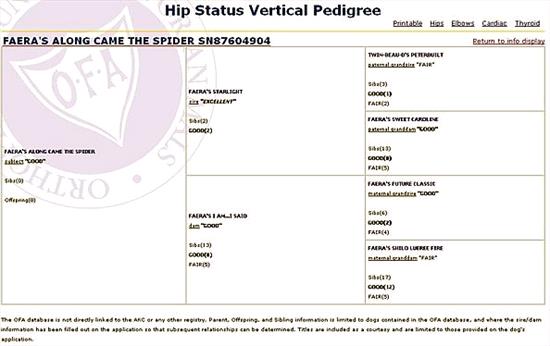
Screen Shot from the OFA website displaying vertical pedigree analysis information. Where available the pedigree shows not only the animals in the direct pedigree line, but summarizes information on sibling data. |
|
| |
The CHIC program offers a variety of benefits to breeders, buyers, parent clubs, and researchers. For breeders, CHIC provides a reliable source of information regarding dogs they may use in their breeding programs. In the future, breeders can begin to analyze the pedigrees of a proposed breeding for health strengths and weaknesses as well the traditional analysis of conformation, type, and performance strengths and weaknesses.
For buyers, the CHIC program provides accurate information about the results of a breeder's health testing. For diseases that are limited to phenotypic evaluations, there are no guarantees. However, the probability that an animal will develop an inherited disease is reduced when its ancestry has been tested normal. Further, as more DNA tests become available and the results are entered into CHIC, the CHIC database will help breeders predict whether progeny will be clear, carriers, or affected.
For parent clubs considering establishment of health databases on their own, CHIC provides the answer with no upfront investment required by the club. The CHIC infrastructure is supplied and maintained by the OFA. The data is maintained in a secure environment by trained staff. The services are not subject to the time, technology, and resource constraints that parent clubs might face on their own. This frees parent clubs to focus on the tasks of identifying health concerns, educating their membership, raising funds for research, and encouraging participation in the CHIC program.
For researchers, CHIC provides confidential and accurate aggregate information on multiple generations of dogs. CHIC information will also be useful for epidemiological studies enhancing our knowledge of health issues affecting all breeds of dogs.
For everyone interested in canine health issues, CHIC is a tool to monitor disease and measure progress.
The Orthopedic Foundation for Animals is a nonprofit 501(c)(3) foundation formed in 1966 with the following objectives:
1. To collate and disseminate information concerning orthopedic and genetic diseases of animals.
2. To advise, encourage and establish control programs to lower the incidence of orthopedic and genetic diseases.
3. To encourage and finance research in orthopedic and genetic disease in animals.
4. To receive funds and make grants to carry out these objectives.
The AKC/Canine Health Foundation is a 501(c)(3) nonprofit organization formed in 1995 with the following mission: To develop significant resources for basic and applied health programs with emphasis on canine genetics to improve the quality of life for dogs and their owners. The AKC/Canine Health Foundation is the largest funder of exclusively canine health research in the world.